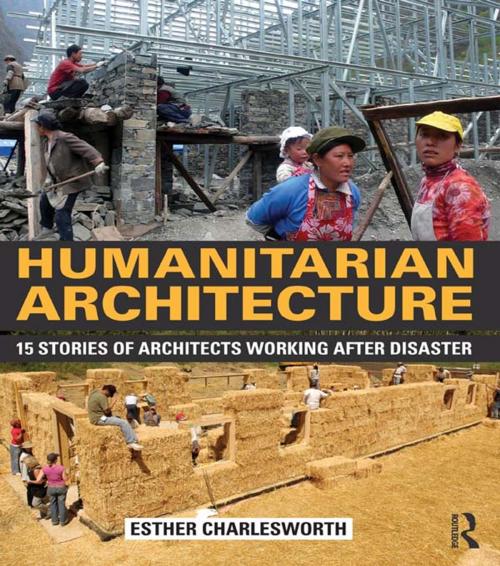Humanitarian Architecture
15 stories of architects working after disaster
Nonfiction, Art & Architecture, Architecture| Author: | Esther Charlesworth | ISBN: | 9781317690788 |
| Publisher: | Taylor and Francis | Publication: | June 27, 2014 |
| Imprint: | Routledge | Language: | English |
| Author: | Esther Charlesworth |
| ISBN: | 9781317690788 |
| Publisher: | Taylor and Francis |
| Publication: | June 27, 2014 |
| Imprint: | Routledge |
| Language: | English |
Never has the demand been so urgent for architects to respond to the design and planning challenges of rebuilding post-disaster sites and cities. In 2011, more people were displaced by natural disasters (42 million) than by wars and armed conflicts. And yet the number of architects equipped to deal with rebuilding the aftermath of these floods, fires, earthquake, typhoons and tsunamis is chronically short.
This book documents and analyses the expanding role for architects in designing projects for communities after the event of a natural disaster. The fifteen case studies featured in the body of the book illustrate how architects can use spatial sensibility and integrated problem-solving skills to help alleviate both human and natural disasters. The cases include:
- Lizzie Babister - Department of International Development, UK.
- Shigeru Ban - Winner of The Pritzker Architecture Prize 2014, Shigeru Ban Architects and Voluntary Architects’ Network, Japan.
- Eric Cesal – Disaster Reconstruction and Resiliency Studio and Architecture for Humanity, Japan.
- Hsieh Ying Chun – Atelier 3, Taiwan.
- Nathaniel Corum - Education Outreach and Architecture for Humanity, USA.
- Sandra D’Urzo - Shelter and Settlements and International Federation of the Red Cross and Red Crescent Societies, Switzerland.
- Brett Moore - World Vision International, Australia.
- Michael Murphy - MASS Design Group, USA.
- David Perkes - Gulf Coast Community Design Studio, USA.
- Paul Pholeros - Healthabitat, Australia.
- Patama Roonrakwit - Community Architects for Shelter and Environment, Thailand.
- Graham Saunders - International Federation of Red Cross and Red Crescent Societies, Switzerland.
- Kirtee Shah - Ahmedabad Study Action Group, India.
- Maggie Stephenson - UN-HABITAT, Haiti.
- Anna Wachtmeister - Catholic Organisation for Relief and Redevelopment Aid, the Netherlands.
The interviews and supporting essays show built environment professionals collaborating with post-disaster communities as facilitators, collaborators and negotiators of land, space and shelter, rather than as ‘save the world’ modernists, as often portrayed in the design media. The goal is social and physical reconstruction, as a collaborative process involving a damaged community and its local culture, environment and economy; not just shelter ‘projects’ that ‘build’ houses but leave no economic footprint or longer-term community infrastructure. What defines and unites the architects interviewed for Humanitarian Architecture is their collective belief that through a consultative process of spatial problem solving, the design profession can contribute in a significant way to the complex post-disaster challenge of rebuilding a city and its community.
Never has the demand been so urgent for architects to respond to the design and planning challenges of rebuilding post-disaster sites and cities. In 2011, more people were displaced by natural disasters (42 million) than by wars and armed conflicts. And yet the number of architects equipped to deal with rebuilding the aftermath of these floods, fires, earthquake, typhoons and tsunamis is chronically short.
This book documents and analyses the expanding role for architects in designing projects for communities after the event of a natural disaster. The fifteen case studies featured in the body of the book illustrate how architects can use spatial sensibility and integrated problem-solving skills to help alleviate both human and natural disasters. The cases include:
- Lizzie Babister - Department of International Development, UK.
- Shigeru Ban - Winner of The Pritzker Architecture Prize 2014, Shigeru Ban Architects and Voluntary Architects’ Network, Japan.
- Eric Cesal – Disaster Reconstruction and Resiliency Studio and Architecture for Humanity, Japan.
- Hsieh Ying Chun – Atelier 3, Taiwan.
- Nathaniel Corum - Education Outreach and Architecture for Humanity, USA.
- Sandra D’Urzo - Shelter and Settlements and International Federation of the Red Cross and Red Crescent Societies, Switzerland.
- Brett Moore - World Vision International, Australia.
- Michael Murphy - MASS Design Group, USA.
- David Perkes - Gulf Coast Community Design Studio, USA.
- Paul Pholeros - Healthabitat, Australia.
- Patama Roonrakwit - Community Architects for Shelter and Environment, Thailand.
- Graham Saunders - International Federation of Red Cross and Red Crescent Societies, Switzerland.
- Kirtee Shah - Ahmedabad Study Action Group, India.
- Maggie Stephenson - UN-HABITAT, Haiti.
- Anna Wachtmeister - Catholic Organisation for Relief and Redevelopment Aid, the Netherlands.
The interviews and supporting essays show built environment professionals collaborating with post-disaster communities as facilitators, collaborators and negotiators of land, space and shelter, rather than as ‘save the world’ modernists, as often portrayed in the design media. The goal is social and physical reconstruction, as a collaborative process involving a damaged community and its local culture, environment and economy; not just shelter ‘projects’ that ‘build’ houses but leave no economic footprint or longer-term community infrastructure. What defines and unites the architects interviewed for Humanitarian Architecture is their collective belief that through a consultative process of spatial problem solving, the design profession can contribute in a significant way to the complex post-disaster challenge of rebuilding a city and its community.















